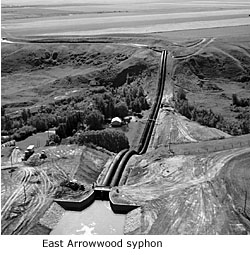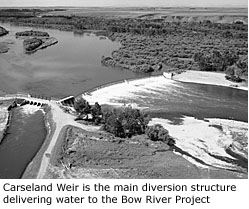Major Irrigation Projects
Bow River Project
Early History
The present-day Bow River Irrigation District, formerly the Bow River Irrigation Project, is
located on the south side of the Bow River between the towns of Taber and Brooks, Alberta. The
Bow River Irrigation Project was started in 1909 by an English firm, the Southern Alberta Land
Company. Several other companies operating in the area at the time acquired land and provided
irrigation works. But financial difficulties and World War I prevented water being made
available. In 1917, the companies merged to form the Canada Land and Irrigation Company.
Although no irrigation water had been delivered prior to amalgamation, much work
had been done. Between 1910 and 1912, about 11 million cubic yards of material, representing
some 260 miles of main and branch canals, had been excavated by horse-drawn scrapers. Dams,
intakes, outlets, flumes, drop structures, headgates, canal bridges and other structures had also
been built.

Water was first delivered in 1920. That year, 9,400 irrigable acres were serviced, followed by
9,800 acres in 1921 when the value of all crops produced averaged $24.77 per acre. Four years
later, 13,830 acres were under the ditch, and revenue reached $42.29 per acre. By 1928, the
irrigable acreage almost doubled, with 131 farmers operating. Early in this development the
Village of Vauxhall sprung up.
The drought of the 1930s made it impossible for dryland farmers to grow crops.
Irrigation farmers, while able to produce crops, were affected by the depression. Grain prices fell
and irrigation farmers, burdened with irrigation costs, could not meet their commitments. As a
result, the company lost money year after year.
Irrigation along the Bow river began in 1905, but owners of the project suffered continual
financial difficulties, and by 1950, only about 20,000 hectares of land had been irrigated. The
federal government saw a good opportunity for expanding irrigation in this area in order to
resettle farmers there in the 1930s. In 1950, the Bow River project was acquired by Canada for
$2.3 million, and PFRA was given responsibility to renovate and further develop it.
Bow River Irrigation Project

The Bow River Project is one of the major irrigation schemes in Western Canada, providing
water for some 120,000 irrigable acres in an area where about 240,000 acres may eventually be
brought under irrigation.
The project, situated west of Medicine Hat, was originally privately owned, but since
1950 has been operated by the Government of Canada. It is one of several projects operated
under the Prairie Farm Rehabilitation Act, with much of the land used to resettle farmers from
drier areas of the three prairie provinces. Many veterans have also been re-established on the
project.
Western and Central Blocks
The Bow River Project is situated in the driest and warmest section of Alberta. The main canal
stretches from Carseland, about 30 miles east of Calgary, to Ronalane. The project is divided into
two blocks -- western and central -- that lie between the Bow and Oldman Rivers, which form its
north and south boundaries.
Water is supplied by means of the Carseland Dam and diversion works on the Bow
River, and about 95 miles of main canal, and hundreds of miles of branch canals and laterals,
ending again at the Bow River just south of Ronalane.
Of the 120,000 acres being irrigated, 25,000 was in the west block which was operated by the
Province of Alberta, and 90,000 acres in the central block was operated by PFRA for the Federal
Government. The central block was divided into two sections, including 63,000 acres in the
Vauxhall district, and 27,000 acres in the Hays region. The latter has been used to resettle
farmers from poor crop areas of Alberta, Saskatchewan and Manitoba.

At the far northwest corner of the project, an area containing 5,000 irrigable acres on the
Blackfoot Indian Reserve is supplied with water, and was operated by first nations people.
Agreement
Following World War 2, plans went forward for Canada to purchase the holdings of the Canada
Land and Irrigation Company, and thereby further PFRA's resettlement program that had already
proved highly successful on the Rolling Hills Project in Alberta, and on several smaller projects
in Saskatchewan.
In 1950, the federal government purchased the company's assets in the project for
over $2,300,000. These assets included over 138,000 acres of land, structures, and equipment.
Canada assumed responsibility for all main reservoirs, works and connecting canals servicing the
three districts. This purchase included the western block which is operated by Alberta, with all
engineering services supplied by PFRA.
Construction

Through PFRA, the Government of Canada embarked on a program to renovate canals and
structures, including the diversion weir and headgates near Carseland. Dams at the north and
south ends of Lake McGregor were each raised 14 feet, and the Little Bow Dam was repaired. A
major structure, the Travers Dam, was added to create a large reservoir south of Lake McGregor.
This dam is 140 feet high and 3,000 feet long. It holds 265,000 acre feet of water, 100,000 of
which are available for irrigation. Scope reservoir, or Reservoir No. 1 south of Hays was also
created by constructing a dam, thus providing four main storage reservoirs. Huge syphons were
built to transport water through several depressions. These syphons improved facilities in the
older established irrigation districts, and have resulted in new lands being opened for settlement.
Before Canada took over the project, the Lake McGregor and Little Bow reservoirs
had a total storage capacity of 200,000 acre feet. Improvements and new construction increased
the usable capacity to 346,000 acre feet. For irrigation, Lake McGregor provided 150,000 acre
feet of water, Travers 100,000, Scope 14,000 and Little Bow 12,000 . These reservoirs, combined
with several smaller ones, provided sufficient water for full development of the project.
Resettlement
The federal resettlement policy was designed to make the shift from one area to another, and
from one type of farming to another, as easy as possible for the farmer and his family. Although
each application was judged on the basis of need. To be eligible, a farmer had to be active and
own at least one quarter section of dry land which he could exchange with PFRA for an irrigated
unit. A farmer's son, on reaching age 21, could also qualify by arranging to have a quarter section
of dry land transferred to him from his father. To avoid speculation, land could not be purchased
for the purpose of exchanging it for an irrigated unit.
Most of the essential features of resettlement carried out on the Rolling Hills Project were used
again on this scheme. Allocation was based on need, with special preference being given to
farmers adjacent to community pastures whose land could be incorporated and developed as
extensions to existing operating pasture units.
Land for irrigation development was allocated to new settlers in exchange for land they left
behind in the drought areas, plus a nominal charge of $2 per acre to cover the cost of initial
breaking and land leveling. Water rights were sold to farmers for $8 per acre, making the basic
price for irrigable land $10 per acre - a sufficiently low cash outlay to be within the means of new
settlers moved to the project.
To help farmers in their transition from dryland to irrigation farming, various services were
offered. These services included assistance in farm layouts design, advice on irrigation techniques
and practices, planting tree shelterbelts, and developing suitable facilities for water supply. Seed
to develop irrigated pastures or for grass-seed production, as well as for grain crops, was
provided at cost and could be paid either in cash or on a crop-share basis in the fall.
Resettlement of the Bow River Project went smoothly with applications consistently exceeding
the number of available land parcels. At present, all parcels are under irrigation and good
production standards maintained. Originally, each farmer was allotted an irrigable acreage
ranging from 110 to 140 acres. In recent years, many farmers have increased the size of their
holdings. As settlers leave the district, their lands have been obtained by other farmers in the
area. Settlers left on account of ill health, better business opportunities elsewhere, and other
reasons.

There were 435 families on
the project. Of these, 132 have come from the drier areas of southern Saskatchewan and Alberta,
and a few from Manitoba. In moving these families to the Bow River Project, PFRA arranged for
the transportation of settlers' effects, the shipment of livestock, and provided them with
temporary accommodation, upon arrival, until houses could be erected on the project. Seed grain
was made available, land leveling and other allied services were provided at cost, and classes
were conducted to help the farmer adjust from dryland to irrigation farming.
The movement of settlers to the project has produced other benefits. The land which
they exchanged for irrigable acreages was taken over by PFRA, re-grassed and otherwise
improved, and turned into pasture that has been made available to farmers remaining in the dry
districts. The additional pasture has enabled many of them to enlarge their herds and place their
farming operations on a better economic basis.
Work carried out by PFRA on the Bow River project has allowed the irrigated area to
more than double since 1950, exceeding 70,000 ha in recent years. Specialty crop production has
been encouraged by the presence of food-processing plants in such centers as Vauxhall and
Taber. Like the St. Mary Irrigation project, the Bow River project was transferred to the province
in 1973 under the Canada-Alberta Irrigation Rehabilitation Agreement and the farmers in the area
were organized into an irrigation district.
Facts about the Bow River Project
- In 1954, the $3 million Travers Dam was built on the Little Bow River, greatly increasing
water storage of the project. The total cost of these and other developments was just under $25
million.
- Four hundred and thirty-six families were relocated to the project by PFRA on 11,000
hectares of land near Hays, Alberta. These settlers were given advice on irrigation practices and
techniques, farm layout, shelterbelt planting and the building of on-farm water supplies to ensure
successfull resettlement.
- The 1968 addition of land expanded the district from a system that irrigated 108,000 acres
to one that now irrigates 210,000 acres.
- Bow River Irrigation District services approximately 670 water users (irrigators), 71
domestic users (dryland farmers), two water co-ops, six oil company groundwater projects,
numerous intensive livestock operations, and all recreation parks and golf courses in the area.
- The region supports such endangered species as the Burrowing Owl, the Great Plains
Toad, and the Piping Plover.




